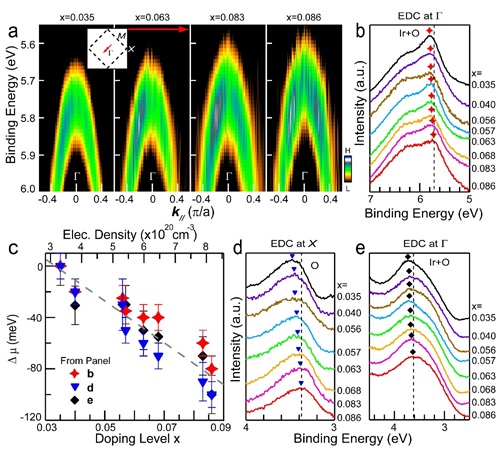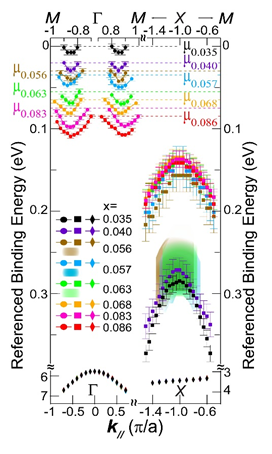Negative compressibility is a sign of thermodynamic instability of open or nonequilibrium systems. In quantum materials consisting of multiple mutually-coupled subsystems, the compressibility of one subsystem can be negative if it is countered by positive compressibility of the others. Manifestations of this effect have so far been limited to low-dimensional dilute electron systems.
In a recent paper published in Nature Materials, researcher Junfeng He from Prof. Ruihua He’s group in Boston College, along with collaborators from Boston College, Northeastern University, SSRL, ALS, Peking University, HiSOR and University of California Santa Barbara, reported the spectroscopic evidence for negative electronic compressibility (NEC) in a three dimensional spin-orbit correlated metal (Sr1-xLax)3Ir2O7, utilizing the high-resolution angle-resolved photoemission spectroscopy (ARPES) experimental setup at SSRL Beam Line 5-4. They found that the increased electron filling accompanies an anomalous decrease of the chemical potential (μ) as indicated by the overall movement of the deep valence bands. Such anomaly, suggestive of NEC, is shown to be primarily driven by the lowering in energy of the conduction band as the correlated bandgap reduces.

Figure 1. Chemical potential shift on electron doping in (Sr1-xLax)3Ir2O7. a, EDC-second-derivative band dispersion maps along the red arrow (inset) in the deep valence band region around the Γ point for selected x values. b,d,e, EDCs at Γ (b,e) and X (d) shown in different energy ranges for various x. a shows the dispersions of the peaks in b. c, Chemical potential shift as a function of x and the calculated electron density, deduced from the corresponding states marked in b, d, e. The chemical potential for x=0.035 is set, for convenience, as a zero reference for the relative shift in chemical potentials.
Photoemission can measure relative changes in μ as a function of doping in the material with reference to electronic states located sufficiently far away from the Fermi level such that their energies are largely unaffected by changes in doping (see Fig. 1). The overall upward shifts of the deep valence bands (Fig. 1 a,b,d,e) indicate the decrease of μ with increasing electron filling (summarized in Fig. 1c).

Figure 2. Doping evolution of the band structure of (Sr1-xLax)3Ir2O7. Extracted dispersions of the conduction band (circles), the shallow valence band (squares and shaded areas) and selected deep valence bands (diamonds, largely overlapping), for various x values. Results are plotted on a common energy scale relative to their respective chemical potentials (dashed lines), with zero defined by that of x=0.035.
In a rigid-band picture, all bands exhibit the same shift in binding energy with fixed inter-band separations. Electron doping in such a case would necessarily lead to an increase of μ and, hence, a positive electronic compressibility. Therefore, the observed decrease of μ suggests a breakdown of the rigid-band picture and necessitates changes in the separations of certain bands in the system.
The scientists noticed that these changes take place in the conduction band and shallow valence band near Fermi level. With electron filling, the bandgap between the conduction band bottom and shallow valence band top decreases, which points to the correlated nature of the low-lying states near μ. Moreover, the movements of the conduction band and shallow valence band are not symmetric as the bandgap shrinks. The conduction band, on which chemical potential is defined, moves down rapidly, resulting in an effective lowering of μ (see Fig. 2). This unique evolution of the correlation gap holds the key to understand the observed NEC.
This work may enable new research on RF/optics and it also points to a distinct pathway toward an uncharted territory of NEC featuring bulk correlated metals with unique potential for applications in low-power nanoelectronics and novel metamaterials.
J. He, T. Hogan, T. R. Mion, H. Hafiz, Y. He, J. D. Denlinger, S.-K. Mo, C. Dhital, X. Chen, Q. Lin, Y. Zhang, M. Hashimoto, H. Pan, D. H. Lu, M. Arita, K. Shimada, R. S. Markiewica, Z. Wang, K. Kempa, M. J. Naughton, A. Bansil, S. D. Wilson and R.-H. He, "Spectroscopic Evidence for Negative Electronic Compressibility in a Quasi-three-dimensional Spin-orbit Correlated Metal", Nat. Mater. 14, 577 (2015), DOI: 10.1038/NMAT4273




